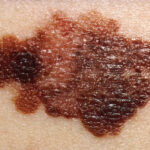Teach Workers the ABCDEs of Skin Cancer

During the summer, workers who work outside are at risk of not only heat stress and other heat-related illnesses but also skin cancer from exposure to the sun.
The sun’s UV rays penetrate the skin and harm the DNA within the cells. Short-term sun exposure can cause sunburns and suntans. But both are signs of skin damage. And long-term exposure may result in sun-induced skin changes’including skin cancer.
So if your workers are outside for much of the workday, they’re at risk of skin damage and even skin cancer from exposure to the sun. That risk is heightened because many outdoor workers are in the sun when its UV radiation is at its strongest: between 12 noon and 2 pm. And although the sun is strongest in the summer, workers are at risk year-round.
The good news is that when skin cancer is detected early, it’s often completely curable. That’s why dermatologists recommend that individuals regularly check their skin for new or changing spots.
When checking moles, freckles or other skin changes, tell your workers to remember the ABCDEs:
|
Other things to look for include areas that:
- Are rough, scaly or lumpy
- Look red or swollen
- Ooze or bleed
- Feel itchy, tender or painful
- Grow back after having been removed.
These signs don’t necessarily indicate cancer’but workers should have them checked by their doctors as soon as possible.
If your workers are exposed to the sun and so at risk of developing skin cancer, take these steps to protect them:
- Implement a sun safety policy (adapt and use this model policy)
- Educate workers on the risks of sun exposure, such as by giving them this handout or hanging this poster or Summer Health & Safety Hazards Infographic in the workplace
- Make sure that workers are properly dressed for working in the sun
- Give this quiz to workers so they can determine their risk of developing skin cancer based on factors such as their colouring, family history of skin cancer and whether they tan or burn.